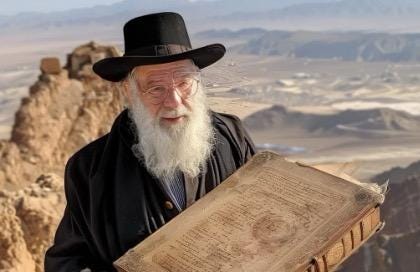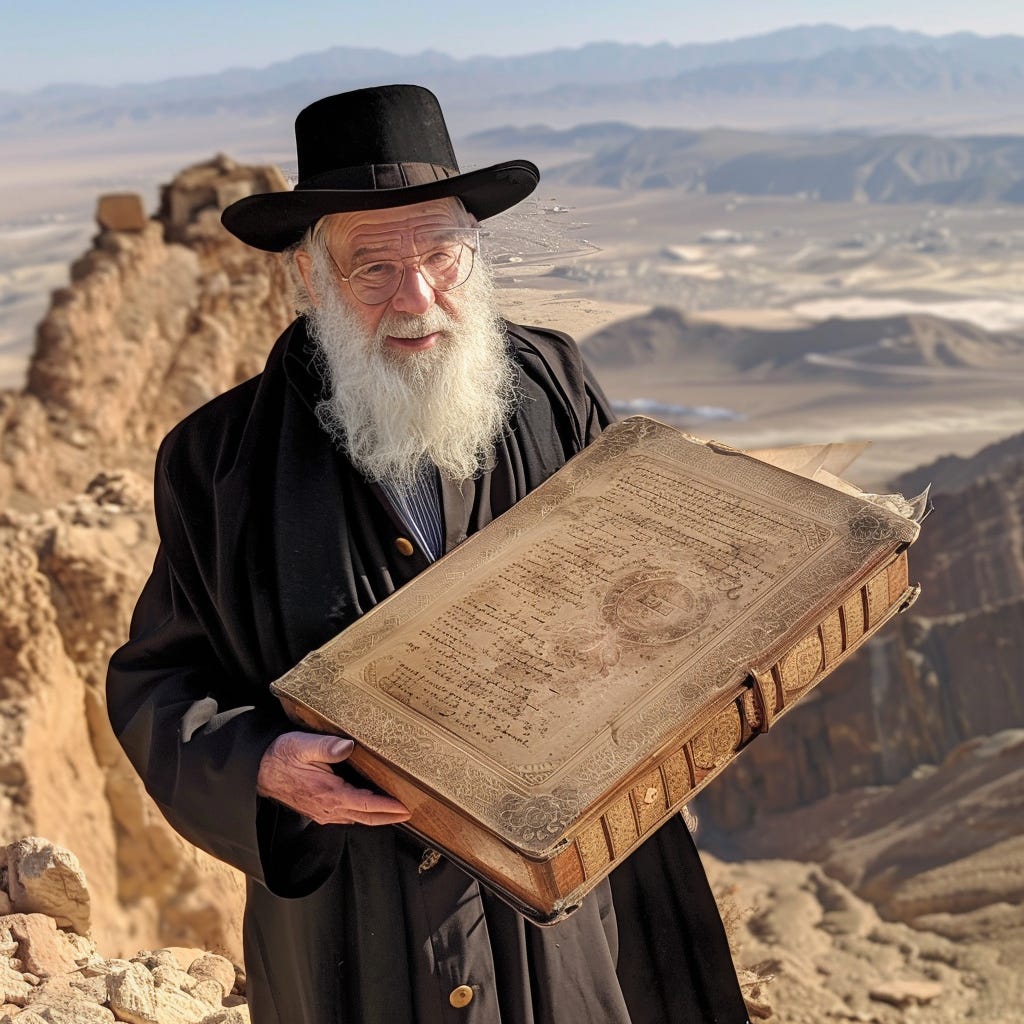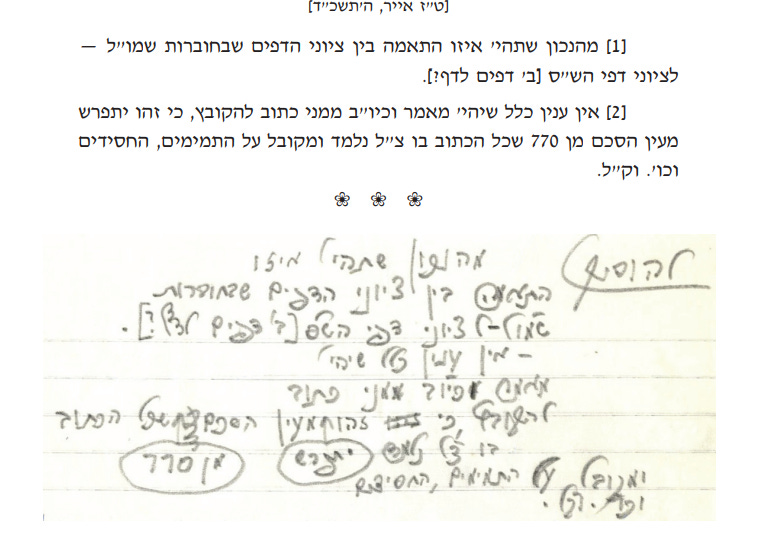Rabbi Steinsaltz and The Second Set of Luchos
On Parshas Ki Sisa and the controversy over writing down the Oral Law
The accompanying shiur is available on the Orthodox Union's parsha learning app: All Parsha.
In the immediate aftermath of the Sin of the Golden Calf, חטא העגל, God tells Moshe to fashion another set of luchos.
וַיֹּאמֶר ה’ אֶל־מֹשֶׁה כְּתׇב־לְךָ אֶת־הַדְּבָרִים הָאֵלֶּה כִּי עַל־פִּי הַדְּבָרִים הָאֵלֶּה כָּרַתִּי אִתְּךָ בְּרִית וְאֶת־יִשְׂרָאֵל׃
The second set of luchos was qualitatively different from the first set. As the Beis HaLevi, Rav Yosef Dov Soloveitchik, explains in his well-known 18th drasha, the first set of luchos are described as the handiwork of God. Within the first set, the entirety of the Torah was discernable to all those who saw it. Both the Written Torah and the Oral Torah, in a clear miracle, were understandable from the words within the first set of luchos. The second set of luchos, however, were carved and created by Moshe himself. Within the second set, only the words on the luchos were understandable. The rest of the Torah needed to be derived through interpretation. The world of the second set of luchos invited and needed our collective interpretation—the efforts of the Jewish People to extract the teachings of the Oral Torah from the Written Law. The Jewish People themselves, through the need for our interpretation, became the vehicles for the holiness of the Torah.
Interestingly, it is from the verse above, that the Talmud derives the prohibition to write down the Oral Torah. It was only because people were forgetting the teaching of the Oral Torah that it was later allowed to be written down. But the world of the second luchos introduced the notion that the Oral Torah should ideally not be written down.
The question is why?
Why specifically now is this prohibition being introduced? And in a world where we now allow the Oral Law to be written down, what can we learn from this prohibition?
To understand all of this, let’s explore the life and some of the polemics surrounding one of the most prolific presenters of the Oral Torah, Rabbi Adin Steinsaltz, and his Talmud project.
Rabbi Adin Steinzaltz (1937-2020) was not raised in a home that centered on Jewish life and practice. His parents were fairly secular—Marxist Zionists—but they had a serious objection to being ignorant. As my friend Rabbi Eli Rubin describes in his incredible biographical overview of Rabbi Steinzaltz’s life, his father hired a Talmud tutor for him at the age of ten. “You can be a heretic,” his father explained, “but you won’t be an ignoramus.”
The world of Torah study opened up his mind and heart—in his teens he decided to enroll in Yeshiva. Still somewhat adrift, his life would change after the Lubavitcher Rebbe, in response to a letter that a teen Rabbi Steinzaltz sent to him, wrote a letter to one of his chassidim, Rabbi Nochum Shmaryahu Sossonkin, asking him to look after the promising young man. “It is apparent from the letter I received from him,” the Rebbe wrote, “that he is sixteen years old and confused about his path in life.” Rabbi Sossonkin invited the young Steinsaltz into the world of intensive Torah study—care that Rabbi Steinsaltz never forgot. In the introduction to his book on teshuva, his dedication is to those rabbis “who many years ago lavished love, time, and patience on one particular boy.”
His genius as both a scholar and an educator quickly spread. He began teaching Torah in small groups and then eventually on Israeli radio. Given his more secular upbringing, audiences were enthralled by his grasp of Torah and all aspects of secular wisdom—one participant praised his grasp of archeology, botany, and history alongside the depths of Torah.
His name, however, will always be synonymous with his Talmud project—Rabbi Steinsaltz’s monumental effort to translate and present the Talmud in a more accessible way to a contemporary Jewish audience. This would be both his gift to the Jewish world and a lightning rod for controversy and criticism.
Making the Talmud more accessible has never been an easy task. Part of the culture surrounding the Talmud is its notable difficulty, and attempts to make it more accessible are always accompanied by concerns that Talmud study itself will be watered down in the process. As Adam Mintz writes in his incredible article, “Words, Meaning, and Spirit: The Talmud in Translation:”
The controversy in the Jewish community between those who favored increased involvement in secular culture and those who wanted to keep Jewish tradition separate and distinct was also fought out in the realm of translations of the Talmud. Attempts to translate this work began in Germany, the home of the Haskalah, in the mid 1800's and continued in the United States and England, countries that inherited this yearning for greater integration. Each of these translations elicited opposition from the more traditional elements of Jewry in these countries. However, ultimately, the need to translate prevailed and translations have come to be recognized by virtually all elements of Judaism.
One gaonic work, Meseches Sofrim, compares the translating of the Torah to the Sin of Golden Calf!
“By the 1840s,” Mintz writes, including a nice shoutout to my favorite year, “the Jews were well entrenched as accepted members of the non-Jewish society in Germany, and they had become familiar with German, while at the same time lacking, for the most part, a knowledge of Hebrew.” Translations were needed but early attempts did not fare well.
In 1842, Dr. Ephraim Pinner published a translation of the first tractate of Talmud, Brachot. It included an approbation from Rabbi Moshe Sofer, known as the Chasam Sofer, that was only hesitantly given. Once the Chassam Sofer discovered that Pinner’s Talmud translation did not have the rabbinic support Pinner originally professed, the Chasam Sofer rescinded his approbation. As discussed in detail by Dan Rabinowitz on the Seforim Blog, Rabbi Sofer later issued a public proclamation distancing himself from Pinner’s work: “I, therefore, ask all the rabbis to prohibit the printing, buying, and reading of this book in their jurisdictions. It must become a closed chapter, never to be mentioned again among the Jewish People."
When Rabbi Steinzaltz began his Talmud project in the early 1960s, he had a different concern. It wasn’t just the content that he had to worry about—it was the presentation. For Rabbi Steinsaltz to present the Talmud with translation, vowelization, and explanatory pictures, he would need to redesign the Talmud page itself. As Efrat Grossman explains in her fascinating article, “Script and Creating a Religious Identity: The Typography of the Talmud,” even changing the design and fonts within the Talmud can cause quite the controversy.
In 1964, Rabbi Steinsaltz wrote to the Lubavitcher Rebbe asking for his advice in terms of the pagination—was it ok to change the traditional page numbers of the Talmud? The Rebbe responded that it should be fine as long as there is some correspondence between the traditional page numbers and those in Steinzaltz’s version. The Rebbe responded to Rabbi Steinsaltz's request for some introductory words by stating that it wouldn't be suitable for him to contribute to Steinsaltz's project. This is because it might suggest that all Lubavitcher Chassidim must accept all the translations and explanations within, which isn't the case.
When the first volume of the Steinsaltz Talmud was finally published in 1989, it set off a furor. Criticism came from all directions. Rav Eliezer Menachem Shach, leader of the Israeli Chareidi community, wrote in a publicized letter that his heart ached to see the sanctity of the Oral Torah being diminished. His precise issue with Steinsaltz’s work is not entirely clear, but his opposition was resolute. Opposition soon followed in the American Yeshiva community.
In a much more detailed critique, published in the January 1990 issue of the Jewish Observer, Rabbi Joseph Elias, points to three objectionable issues:
(1) The faulty picture drawn of Torah She Be’al Peh, the Oral Law
(2) The misrepresentation of our sages
(3) The rejection of the concept of Chasimas Hatalmud and the consequences that flow from it.
Rabbi Elias does marshal many examples from Steinsaltz’s work of what he feels falls short of the type of reverence needed when discussing the Talmud. He often takes issue when Steinsaltz presents the Oral Law’s interpretation of biblical law in a way that emphasizes a later development of the Oral Law rather than a simultaneous revelation at Sinai. Still, looking back, it is hard not to question whether the controversy surrounding Rabbi Steinsaltz was about more than his actual Talmud Project and not about other factors, such as his affiliation with Chabad and his outreach, teaching Torah in secular settings.
Rabbi Elias’s critique was overly harsh for many, even at the time. On the cover of the November 1990 issue of the Jewish Observer, was a question many must have been asking, “Does JO (Jewish Observer) Recognize Two Sides to the Steinsaltz Talmud Dispute?” Inside, they published a lengthy defense of Steinsaltz’s Talmud written by Rabbi Matis Greenblat, who served as editor of the Orthodox Union’s magazine, Jewish Action. Rabbi Greenblat reminds readers that Rabbi Steinsaltz did, in fact, receive approbation from Rabbi Moshe Feinstein, who was recognized as the senior rabbinic leader in the United States at the time. His article acknowledges that some mistakes may have been made, a point Rabbi Steinsaltz himself readily conceded, but reminds his audience of the enormous potential that the Steinsaltz Talmud had for bringing Talmud to new previously unaffiliated readers. “The fact remains,” writes Rabbi Greenblat, “that Rabbi Steinsaltz has the ability to reach those who were previously unreachable.”
The Jewish Observer was not the only American outlet to criticize the Steinsaltz Talmud. In the Summer 1991 issue of Tradition, the journal of the Rabbinical Council of America, Rabbi Ahron Feldman published a critique entitled “Learning Gemara in English: The Steinsaltz Talmud Translation.” Rabbi Feldman, whose brother Rabbi Emanuel served as the editor at the time, called the beauty of the Steinsaltz Talmud “skin deep.” He concludes that “this massive undertaking falls disappointingly short of its mark.”
Interestingly, Rabbi Feldman acknowledges, the Artscroll Schottenstein Talmud project never received such widespread scrutiny. Only two volumes of the Artscroll Talmud had been published when Rabbi Feldman wrote his review. Still, now living in an Artscroll-translated world, one wonders why their translation escaped such serious controversy. No doubt Artscroll’s close coordination with leading rabbinic leaders helped stem the tides of rabbinic opposition. The Artscroll Talmud project also begins with an acknowledgment of the guidance of Rabbi Yosef Sholom Elyashiv, who felt that once there are already so many translations available it is best to rely on one that was produced with the oversight of established leaders in the Yeshiva world. Curiously, Artscroll, the master translator, left Rabbi Elyashiv’s introductory remarks untranslated.
For his part, Rabbi Steinsaltz never spent much time responding to his critics. Instead, he focused on producing more gateways into Torah learning—his lifelong project that became synonymous with his name. Rabbi Steinsaltz also never called upon his Rebbe, the Lubavitcher Rebbe, to step into the fray of controversy surrounding the Steinsaltz Talmud. “The rebbe has enough tzaros of his own,” Rabbi Steinsaltz once said. To those who criticized the change of the Talmud page, Rabbi Steinsaltz felt such issues were grounded in ignorance. As Efrat Grossman shares in her article, Rabbi Steinsaltz responded that the Talmud layout we have before us was one of many. Even Rashi script, Rabbi Steinsaltz felt, was really just a font created to differentiate between the words of the Torah and its commentaries.
The true receptacle of holiness, as Rabbi Steinsaltz’s legacy attests, resides in the hearts and minds of those who study the Talmud. Fusing our Oral Torah to our very selves and preserving the great project of the Talmud throughout the generations.
The Sin of the Golden Calf begins with Moshe’s delay coming back from Sinai. The Jewish People are bereft without Moshe and build an idol to serve in his place.
The Jewish People cannot imagine preserving the Torah without their teacher Moshe—the greatest prophet who ever lived. How can we develop Torah throughout the generations without Moshe?
And this is why the second set of luchos needed to be qualitatively different. As opposed to the first set of luchos, the second set of luchos required the effort and interpretations of the Jewish People to develop the Torah within. It was a reminder to the Jewish People that even in a world without the greatest prophet, Moshe, the ultimate vehicle for Torah study will remain in the hearts and minds of the Jewish People.
That is why specifically following the story of the Golden Calf we are introduced to the prohibition of writing down the Oral Torah. It is specifically this shift that ensured that the primary vehicle of Torah is never the text, but the collective interpretations preserved by the Jewish People throughout the generations. And that must always remain unwritten—preserving the vitality and fluidity of our own lives and perspectives. As Rav Tzadok writes on this parsha, the most essential part of the Oral Torah is our personal experiences and narratives through which we approach the fixed words of the Torah. And it is those experiences that cannot, by their very nature, ever be written down. That is why, Rav Tzadok explains, the Talmud uses the term אליבא, to mean “according to,” because it is through the prism of our hearts that we truly develop the Oral Torah.
Our very lives remain the ultimate vehicle for the development of the Oral Torah, and those experiences will always remain unwritten, preserved on the pages of our hearts.
Shabbos Reads — Books/Articles Mentioned
Marked by Fire: The Making of Rabbi Adin Even-Israel (Steinsaltz), Eli Rubin
Words, Meaning and Spirit: The Talmud in Translation, Adam Mintz
The Hatam Sofer’s Retraction of his Approbation to the Pinner Talmud, Dan Rabinowitz
Some Notes on the Pinner Affair, Shnayer Leiman
Script and Creating a Religious Identity: The Typography of the Talmud, Efrat Grossman
Popularizing the Talmud: An Analytical Study of the Steinsaltz Approach to Talmud, Joseph Elias
Rabbi Steinsaltz’s Approach to the Oral Tradition—Revisited, Matis Greenblatt
Learning Gemara in English: The Steinsaltz Talmud Translation, Ahron Feldman
Check out All Parsha, where you can find weekly audio of Reading Jewish History in the Parsha, as well as other incredible presenters and amazing features that will enhance your Parsha journey!
Reading Jewish History in the Parsha has been generously sponsored by my dearest friends Janet and Lior Hod and family with immense gratitude to Hashem.















Question: with this explanation, what was gods original plan with the luchos/torah. That it should never have human input? What would be a humans job in such case? There would essentially be a very clear yes or no answer to any and every halachik and hashkafic question.